Our website relies on reader support, which means that we may receive a small commission from Amazon and other affiliates if you make a purchase through links on our site.
Roses are widely regarded as the queen of flowers due to their popularity worldwide. Despite their beauty, however, they are not immune to problems such as diseases. Blackspot, rust, and mildew are some of the most common issues that roses face. While there are some rose cultivars that are designed to be more resistant to pests and diseases, it is rare to find a rose that doesn’t suffer from at least one issue.
In this article, we will discuss some of the most common issues that roses face, and provide tips on how to combat them, and even better, prevent them in the first place. There are several diseases and fungi that can affect roses, with black spot being the most prevalent.
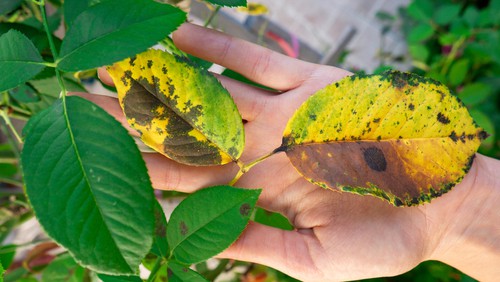
Blackspot, a fungal disease commonly found in roses, can produce spores within a few hours. The Diplocarpon rosae fungus can lead to defoliation and eventual stem dieback, apart from negatively impacting the appearance of the plant. This disease is characterized by black spots on the foliage that develop into discolored patches. As a result, infected yellow leaves may fall off, leading to limited foliage for food production. To treat the plant, one should remove the diseased sections and apply a fungicide such as Bordeaux Mix, neem, RoseClear, or those containing myclobutanil and mancozeb. Adequate ventilation and avoiding direct water spraying can prevent fungal growth, as damp and warm conditions promote fungi. Spraying roses with a fungicide like RoseClear when they start sprouting leaves in spring can be an effective way to prevent blackspot, powdery mildew, and downy mildew, as I will discuss later. Powdery mildew, another fungal disease, causes a white coating on all parts of roses.
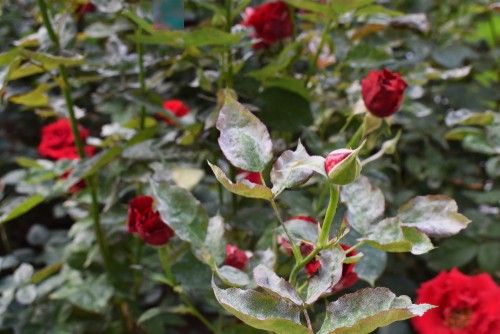
If you notice a white powdery substance on your rose bushes, you may be dealing with powdery mildew. This fungal infection caused by Sphaerotheca pannosa can damage the young foliage, leading to crinkling and spreading of a white coating. If left unaddressed, powdery mildew can also affect the stems and flowers. Powdery mildew prefers humid conditions and can remain dormant until it finds the perfect conditions to reproduce. To prevent the disease from weakening your plants, it is best to apply garden fungicides. You can use chemical treatments like propiconazole, myclobutanil, propiconazole, and hexaconazole, or organic methods like sulphur, milk, metal salts, neem oil, or potassium bicarbonate. Another genetic method involves using the Pm3 allele in breeding to boost the plant’s immune system against powdery mildew. Personally, I opt for a general fungicide to treat my plants. Additionally, if you see orange spots on your rose leaves, you may be dealing with rust, which is also easy to identify.
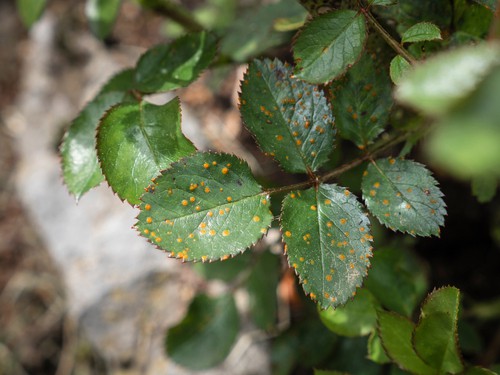
Phragmidium mucronatum, also known as rust disease, is a type of fungus that only affects roses during spring and summer. It forms orange pustules on the underside of leaves, which can cause stems to distort and leaves to fall prematurely, leading to weaker plants. To treat the airborne fungus, one can remove the infected areas and use fungicides that contain tebuconazole or triticonazole, as well as products that combine insecticide and pesticides like myclobutanil and cypermethrin or triticonazole and acetamiprid. Alternatively, bicarbonate of soda or lime sulphur can be used, or a general rose treatment such as RoseClear since it kills aphids too.
Downy mildew caused by Peronospora sparsa is a fungi that produces dark brown or purplish-red angular blotches on rose leaves, affecting young leaves, buds, blooms, and stems, resulting in purple lesions that weaken the plant until defoliation occurs. The infection can be managed by removing the diseased stems, buds, and leaves and using fungicides that contain copper regularly until the infection subsides. One should always follow the instructions to avoid further damage to the plant.
Botrytis is another fungal disease that affects roses, causing a grey mould on buds, flowers, and leaves. This fungus thrives in humid conditions and can infect roses through wounds, deadheading, and pruning. To prevent Botrytis, one can remove wilted flowers and leaves and avoid overwatering the roses. Applying a fungicide that contains tebuconazole or trifloxystrobin can also be effective in controlling this disease.
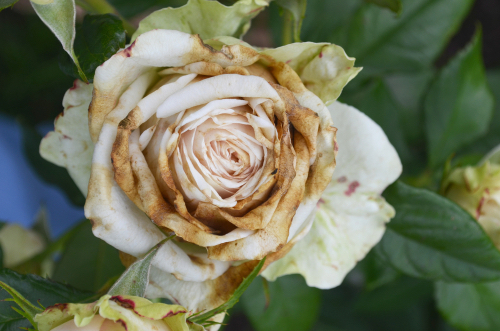
Botrytis cinerea, a fungal infection that commonly affects roses, causes grey or brown mould that leads to rotting of the hips or blooms. This airborne pathogen thrives in cool humid weather and can quickly spread to damage buds, leaves, stems, and petals, resulting in wilted and disfigured plants. To combat this disease, infected areas must be removed and fungicides, whether organic or chemical, must be applied promptly. However, it should be noted that the effectiveness of fungicides may be limited due to the pathogen’s genetic plasticity. Organic alternatives such as Trichoderma harzianum and Streptomyces lydicus can also be used to parasitize or deprive the fungi of nutrients.
Cane canker is another fungal infection that can affect roses if they are left unattended and without proper nourishment. This disease seeps into the plant’s system through open wounds and slowly kills the stem. Early signs of cane canker include small red or yellow spots on the plant’s bark, which then develop into noticeable brown cankers with dark margins. The infected stem becomes sunken and eventually leads to the plant’s demise. Removing the diseased sections with sterilised secateurs and using fungicides can help the plant recover.
In contrast, crown gall on roses can be devastating, and affected plants are best removed.
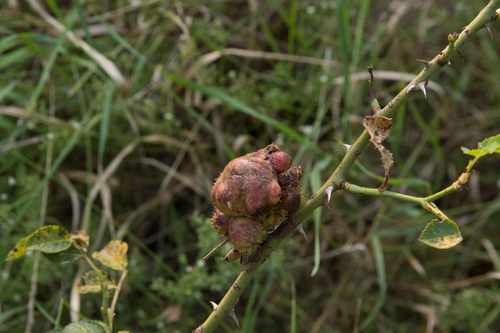
Crown gall is a plant disease that can affect various types of plants, not just roses. This infection occurs when wounds on the plants are left untreated and allow the Agrobacterium tumefaciens bacterium to enter the system. The pathogen disrupts the plant’s ability to absorb water and nutrients, leading to the development of light-colored tumors at the crown that eventually turn black or dark brown. The roots may also be affected, causing the plant to wilt and die. Preventive measures are the best way to manage this disease, such as avoiding causing wounds during pruning and using disinfected equipment. Planting disease-free roses in well-ventilated and well-drained soils can also help prevent future problems. In severe cases, removing the affected plants may be the best option. Additionally, aphids are common pests that love to infest rose plants.
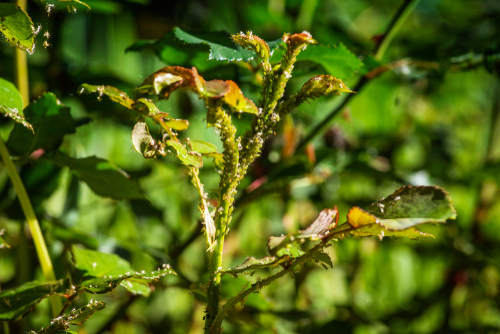
Aphids are not well-liked by plants as they feed on their sap, resulting in disfigurement. They also produce honeydew, a sugary substance relished by tiny insects like ants, which leads to the growth of sooty mould that spreads slowly and harms the plant. It is crucial to manage aphid populations as they multiply rapidly. A low-cost remedy is to use insecticidal soap or fatty acid salts. Alternatively, specialised chemical insecticides can be employed, but following instructions is essential to avoid further damage to roses. At the first indication of aphids, I suggest treating roses with a pesticide.

Similar to aphids, thrips also feed on rose sap for nutrients, which can lead to deformities. Although they aren’t highly destructive in small numbers, large populations can affect the health of the roses. These tiny insects tend to hide in flowers and underneath leaves, and their presence can be identified by a noticeable silvery appearance. To control thrips, you can use natural predators like ladybirds, horticultural soap, or pesticides containing pyrethrins or acetamiprid.
Rose slugs are larvae of sawflies that resemble real slugs but consume rose leaves, giving them a translucent look. In small numbers, they don’t damage the plant’s health but can weaken it in large numbers. You can control them by attracting birds or using insecticidal soap, neem oil, or specialised insecticides.
Japanese beetles are another pest that eats all parts of roses.
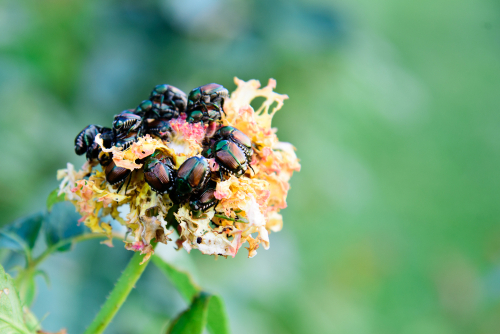
The Japanese beetle is a troublesome insect that can cause severe damage to plants. They attack in large numbers, leaving plants to suffer irreparable damage. This menacing insect doesn’t stop at consuming the leaves but also goes for the flowers, which leads to a disfigured plant. Spotting these pests is easy since they don’t hide; they just eat the plant outright.
To manage the Japanese beetle problem, pesticides that contain pyrethrins are commonly used. However, neem oil has also proven effective in stopping these insects from feeding on the plant further. Additionally, using nematodes to eliminate Japanese beetle grubs before they mature is recommended because adult beetles are much harder to deal with.
Apart from Japanese beetles, rose curculios are another pest that can make gardening a nightmare.
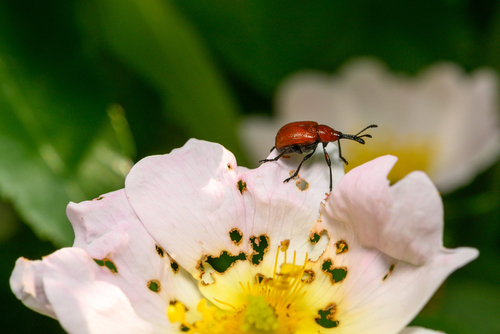
Rose curculios are a type of small weevil that can cause significant damage to plants. They have reddish-brown spotted bodies and both their larvae and adult forms can be harmful, particularly if they are in large numbers. These weevils prefer white or yellow roses and lay their eggs inside the buds. Once the buds open, the grubs will have already caused damage. While you can try to remove them by hand, it may take some time, especially if there is a severe infestation. Alternatively, you can use insecticides or natural predators like wrens and bluebirds to get rid of them.
It’s worth noting that roses are more prone to diseases and pests than other plants. Blackspot, rust, and mildew are common problems that can disfigure your blooms or even kill your plant. Therefore, it’s essential to act quickly when you notice something is wrong. Take some time to observe the symptoms, identify the probable cause, and deal with it before things get worse. While caring for roses requires patience, the beautiful blooms make it all worthwhile. To prevent diseases, you might want to treat your roses with fungicide as soon as they start growing leaves in the spring.

It seems like the leaves on your rose plants are curling, which could be a result of pests or diseases. One possible culprit could be a pest known as Rose sawfly, but we’ll delve deeper into that later. Alternatively, it could be powdery mildew, which is recognizable by its white and delicate coating. Let’s take a closer look at both possibilities to determine what might be causing the issue.

For many years, roses have been linked to the classic English garden. Growing them has been a passion of mine for more than two decades, while my family has cultivated them on our nursery for over 40 years. However, there are now whispers that growing roses is a challenging task…

It’s possible that your roses are experiencing stress if they’re shedding their leaves. This could be a result of various factors like environmental conditions, weather changes, pest and disease infestations, or improper care. Conversely, if you notice your roses losing their leaves…





